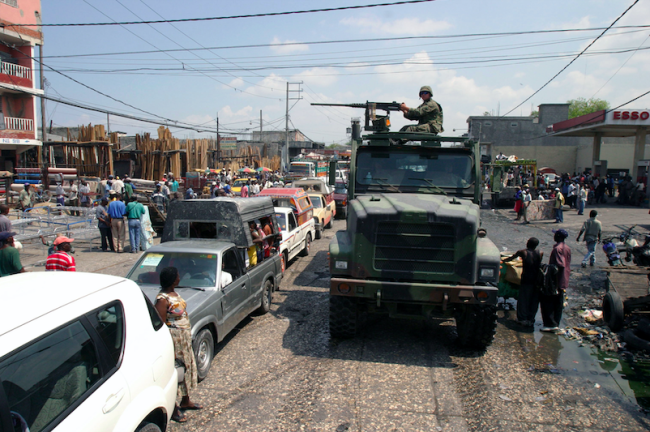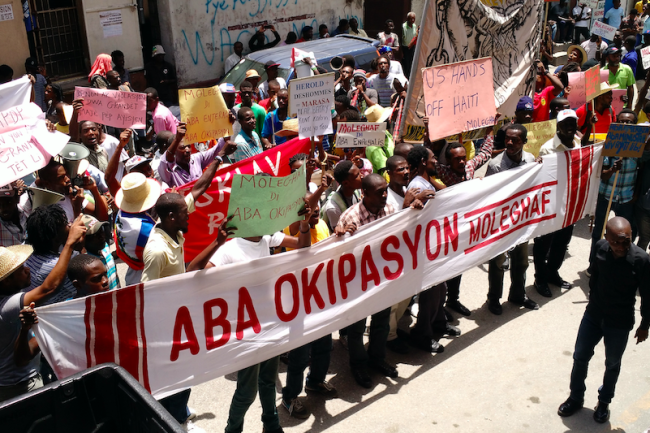
This piece appeared in the Fall 2023 issue of NACLA's quarterly print magazine, the NACLA Report. Subscribe in print today!
In December 2019, President Donald Trump signed into law H.R.2116, also known as the Global Fragility Act (GFA). Although this act was developed by the conservative United States Institute of Peace, it was introduced to Congress by Democratic Representative Eliot L. Engel, then chair of the House Committee on Foreign Affairs, and cosponsored by a bipartisan group of representatives, including, significantly, Democrat Karen Bass. The GFA presents new strategies for deploying U.S. hard and soft power in a changing world. It focuses U.S. foreign policy on the idea that there are so-called “fragile states,” countries prone to instability, extremism, conflict, and extreme poverty, which are presumably threats to U.S. security.
Though not explicitly stated, analysts argue that the GFA is intended to prevent unnecessary and increasingly ineffective U.S. military interventions abroad. The stated goal is for the United States to invest in “its ability to prevent and mitigate violent conflict” by funding projects that mandate “an interagency approach among the key players, including the United States Agency for International Development (USAID) and the Departments of State, Defense, and the Treasury” amid collaboration with “international allies and partners.”
In April 2022, the Biden-Harris administration affirmed its commitment to the GFA by outlining a strategy for its implementation. As detailed in the strategy’s prologue, the U.S. government’s new foreign policy approach depends on “willing partners to address common challenges, [and] share costs.” “Ultimately,” the document continues, “no U.S. or international intervention will be successful without the buy-in and mutual ownership of trusted regional, national and local partners.” The Biden administration has also stressed that the GFA will use the United Nations and “other multilateral organizations” to carry out its missions. The prologue outlines a 10-year plan for the GFA that, according to the U.S. Institute of Peace, will “allow for the integration and sequencing of U.S. diplomatic, development, and military-related efforts.” Among five trial countries for GFA implementation, Haiti is the first target.
Hailed by development experts as “landmark” legislation and, as Foreign Policy reported, a “potential game-changer in the world of U.S. foreign aid,” the act seems to offer a reset of U.S. foreign policy in ways that shift tactics while maintaining the objectives and strategies of U.S. global domination. The act and its prologue clearly articulate that its main goals are to advance “U.S. national security and interests” and to “manage rival powers,” presumably Russia and China. In this sense, especially for governments and societies in the Western Hemisphere, the GFA can be seen as a revamping of the Monroe Doctrine, the 1823 U.S. foreign policy position that established the entire region as its recognized sphere of influence, shaping U.S. imperialism. The GFA deploys cunning language—tackling the “drivers” of violence, promoting stability in “conflict-prone regions,” supporting “locally-driven political solutions”—that hides the legislation’s real intent: to rebrand U.S. imperialism.
In their deliberations on the Global Fragilities Act, U.S. officials labeled Haiti as one of the world’s most “fragile” states. Yet this supposed fragility has been caused by more than a century of U.S. interference and a consistent push to deny Haitian sovereignty. Throughout a long history and complex—though blatant—imperialism, Haiti has been and continues to be the main laboratory for U.S. imperial machinations in the region and throughout the world. It is no surprise, therefore, that Haiti is the first object in the United States’ latest rearticulation of a policy for maintaining global hegemony.
In fact, a review of the actions of the United States and the so-called “international community” in Haiti from 2004 to the present demonstrates how Haiti has served as the testing ground—the laboratory—for much of what is encapsulated in the Global Fragilities Act. The GFA, in other words, is not so much a new policy as it is a formal expression of de facto U.S. policy toward Haiti and Haitian people over the past two decades. Without recognizing these uses and abuses of Haiti, the site of the longest and most brutal neocolonial experiment in the modern world, we cannot fully understand the workings of U.S. (and Western) hegemony. And if we cannot understand U.S. hegemony, then we cannot defeat it. And Haiti will never be free.
Sovereignty Again Denied
Since 2004, Haiti has been under renewed foreign occupation and lacks sovereignty. This is not hyperbole. Take, for example, a series of events and actions following the July 7, 2021 assassination of Haiti’s arguably illegitimate but still sitting president, Jovenel Moïse. The day after the assassination, Helen La Lime, head of the United Nations Integrated Office in Haiti (BINUH), declared that interim prime minister Claude Joseph would lead the Haitian government until elections were scheduled. Because of Joseph’s interim status, however, the line of succession was unclear. Days before his killing, Moïse had named neurosurgeon and political ally Ariel Henry as prime minister to replace Joseph, but he had not yet been sworn in.
A few days after Moïse’s assassination, the Biden administration sent a delegation to Haiti to meet with both Joseph and Henry, as well as with Joseph Lambert, who had been chosen by Haiti’s 10 remaining senators—the only elected officials in the country at the time—to stand in as president pending new elections. Despite these competing claims to power, Washington chose a side. The U.S. delegation sidelined Lambert, convinced Joseph and Henry to come to an agreement over Haiti’s governance, and urged Joseph to stand down.

A week later, on July 17, BINUH and the Core Group—an organization of mostly Western foreign powers dictating politics in Haiti—issued a statement. They called for the formation of a “consensual and inclusive government,” directing Henry, as the designated prime minister named by Moïse, “to continue the mission entrusted to him.” Two days later, on July 19, Joseph announced he would step aside, allowing Henry to assume the mantle of prime minister on July 20. The “new”—and completely unelected—government and cabinet was composed mostly of members of the Haitian Tèt Kale Party (PHTK), the neo-Duvalierist political party of Moïse and his predecessor Michel Martelly. In the wake of the devastating 2010 earthquake, the PHTK, with Martelly at the helm, was put in place by the United States and other Western powers without the support of the Haitian masses.
After the U.S. Embassy, the Core Group, and the Organization of American States (OAS) released similar statements applauding the formation of a new “consensus” government, U.S. Secretary of State Antony Blinken affirmed support for the unelected leaders. “The United States welcomes efforts by Haiti’s political leadership to come together in choosing an interim prime minister and a unity cabinet,” he said in a statement. In effect, Haiti’s true power brokers—or what I have called the “white rulers of Haiti”—determined the Haitian government’s replacement through a press release.
Meanwhile, the international community’s decision-making process completely left out Haiti’s civil society organizations, which had been meeting since early 2021 to find a way to resolve the country’s political crisis as Moïse, already ruling by decree, was poised to overstay his constitutional mandate. These groups adamantly rejected the foreign-imposed interim government and have criticized the international community’s actions as blatantly colonial.
Who and what are the entities making decisions for Haiti and the Haitian people, and how did they claim such prominent roles in controlling Haitian politics? Haitians are not members of the BINUH, OAS, or Core Group. But also central is the question of the country’s sovereignty—or lack thereof. Haiti has been under foreign military and political control for almost 20 years. But this is not the first time, of course, that Haiti has been under occupation.
Legacies of Foreign Control and Occupation
In the summer of 1915, U.S. Marines landed in Port-au-Prince and initiated a 19-year period of military rule that sought to snuff the sovereignty of the modern world’s first Black republic. During this first occupation, as I have written elsewhere with Peter James Hudson, “the US rewrote the Haitian constitution and installed a puppet president [who signed treaties that turned over control of the Haitian state’s finances to the U.S. government], imposed press censorship and martial law, and brought Jim Crow policies and forced labor to the island.” In line with its racist view that Black people do not have the capacity for civilization or self-government, Washington rationalized that it was necessary to teach Haitians the arts of self-government—a view that continues today.
But the most pronounced labor of the U.S. Marines was counterinsurgency. They waged a “pacification” campaign throughout the countryside to suppress a peasant uprising against the occupation, using aerial bombardment techniques for the first time. Dropping bombs from planes onto Haitian villages, the pacification campaigns left more than 15,000 dead and countless others maimed. Those who survived and continued to resist were tortured and forced into labor camps.
The United States finally left the country in 1934 after massive grassroots protests by the Haitian people. But one of the most consequential results was the establishment and training during the occupation of a local police force, the Gendarmerie d’Haïti. For years, this police force and its successors were used to terrorize the Haitian people, a legacy that continues today.
In the years after the 1915-1934 occupation, the United States continued to intervene politically and economically in Haitian affairs. The most notorious of these engagements was the U.S. support for the brutal dictatorship of Francois “Papa Doc” Duvalier and Jean-Claude “Baby Doc” Duvalier. In the first democratic elections after the fall of the Duvalier regime, the United States unsuccessfully tried to prevent the ascension of the popular candidate, Jean-Bertrand Aristide. However, nine months after his January 1991 election, Aristide was deposed in a CIA-bankrolled coup d’état. The coup was not consolidated, though, because of continuous resistance from the Haitian people. By 1994, U.S. president Bill Clinton’s administration was forced to bring Aristide back to Haiti after three years in exile—with 20,000 U.S. troops in tow. Aristide was now a hostage to U.S. neoliberal policy. The troops remained until 2000.
Read the rest of this article, available open access for a limited time.
Jemima Pierre is Professor of African American Studies and Anthropology at UCLA and a research associate at the Center for the Study of Race, Gender and Class at the University of Johannesburg. She is the author of The Predicament of Blackness: Postcolonial Ghana and the Politics of Race and numerous academic and public articles about Haiti.

